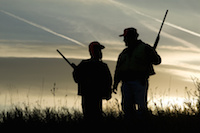 For thousands of New Zealand hunters, the humble .22 rifle is often the first firearm they learn to use, and for many of us it remains a favourite throughout our lives.
For thousands of New Zealand hunters, the humble .22 rifle is often the first firearm they learn to use, and for many of us it remains a favourite throughout our lives.
I got my first when I was about 13, on the farm with rabbits and hares, and with goats, pig and deer further up the valley. It was a Canadian Cooey tube-magazine bolt-action rifle with open sights and a semi-bull barrel (wonderful in-house jargon, isn’t it?), and with it I shot a substantial amount of meat for the pot – my mother was particularly good at producing beautifully-roasted rabbit wrapped in bacon.
I still have that sturdy little .22 Cooey, half a century on, and it still shoots superbly.
Young people find the .22 light and simple to use, and there’s a variety of single-shot guns available that help newbees understand how firearms work while providing maximum safety to themselves and others around them.
Almost invariably, those who learn to shoot with one of these little single-shot rifles establish life-time habits of sensible use, quickly realising the value of placing that first shot accurately. Many a youngster has been sent out by Dad or an uncle with just three .22 cartridges with instructions to “bring home at least two rabbits”. Such requirements tend to rapidly sharpen both hunting and shooting skills.
But most people have little knowledge of the history of the little and often under-rated .22 cartridge, and also the fact that there was a wide number of different similar but not interchangeable .22 rimfire rounds that appeared and have since fallen by the wayside.
The .22 began life in minimal circumstances – as a short-cased Flobert BB cap cartridge, in 1845. A dozen years later, the classic little .22 Short was born, loaded with black powder and used in a Smith and Wesson revolver.
This little cartridge is still in production, 150 years on, and is acknowledged as the longest continuous-production self-contained metallic cartridge in the world. From it sprang a bunch of follow-ons, most of which have since died. Several went on to bigger and better things, and have been the inspiration for more modern additions to the fascinating world of cartridges.
The .22 Short is still made by the hundreds of millions each year, widely used for gallery or target shooting and, with the advent of high-velocity loadings in 1930, as a small-game round.
The .22 Long appeared in 1871, using the light 29-grain bullet from the Short cartridge fitted into a longer case, and with the early loads of black powder. Within two decades it, the Short and the newly-introduced (1887) .22 Long Rifle round were being loaded with semi-smokeless powder, and soon afterwards smokeless powder was widely used.
But the .22 Long Rifle cartridge – the one most commonly seen on New Zealand gunshop shelves these days – had to work hard to become the most popular of small-game and target rounds.
It faced competition from the .22 Extra Long of 1880; the .22 Winchester Rimfire or .22WRF, introduced in 1890; the .22 Winchester Automatic of 1903; and the almost identical .22 Remington Automatic of 1914. All four, during the next 50 to 70 years, faded into obscurity, leaving the .22LR “boys’ bullet” pretty much on its own.
It is manufactured world-wide, probably by the billions each year, and is still used nationwide in this country for indoor and outdoor target shooting, and the hunting of rabbits, wild cats, hares, wallabies, possums, goats, and even pig and deer.
For many years the .22LR cruised happily as supersonic (about 1250 feet per second for the 36 to 40-grain hollow or solid bullets), and also standard velocity (about 1150 fps) or subsonic (less than 1000 fps). Now there’s an ever-expanding line-up in this calibre, including hyper-velocity (over 1450 fps), segmented bullets, super-subsonic (below 700 fps), and 60-grain projectiles in Short cases.
There have also been other additions to the little rimfire line-up in the past half-century, notably the .22 Winchester Magnum of 1959 – still a popular calibre – and the 5mm Remington Magnum, in 1970. The Remington round was appreciably better than the Winchester Magnum, yet it never caught on, and production ended within a decade.
I saw a price tag of $90 on a packet of 50 of these cartridges recently.
Incidentally, old .22 WRF rounds work perfectly well in .22 Magnum bolt-action guns, though semi-autos may not be happy with them.
Within the past decade or so three new “mighty-micros” have appeared – the .17 HMR (Hornady Magnum Rimfire), which arrived in 2002, its feisty little brother, the .17 Mach 2, and more recently the .17 Aguila.
All are super-quick, either at or just over 2000 feet per second, and appear excellent for small-game hunting. Time will tell just how good they really are.
In the meantime, I’ll stick with my .22LR rifles – they’re cheap and fun to use, I know their limitations, and they’re old and trusted friends.
Kingsley Field is a Hamilton columnist, and has published two illustrated books of his outdoor columns. He is now working on his third. He can be contacted at kingsley(at)accuwrite.co.nz.









Join the Discussion
Type out your comment here:
You must be logged in to post a comment.